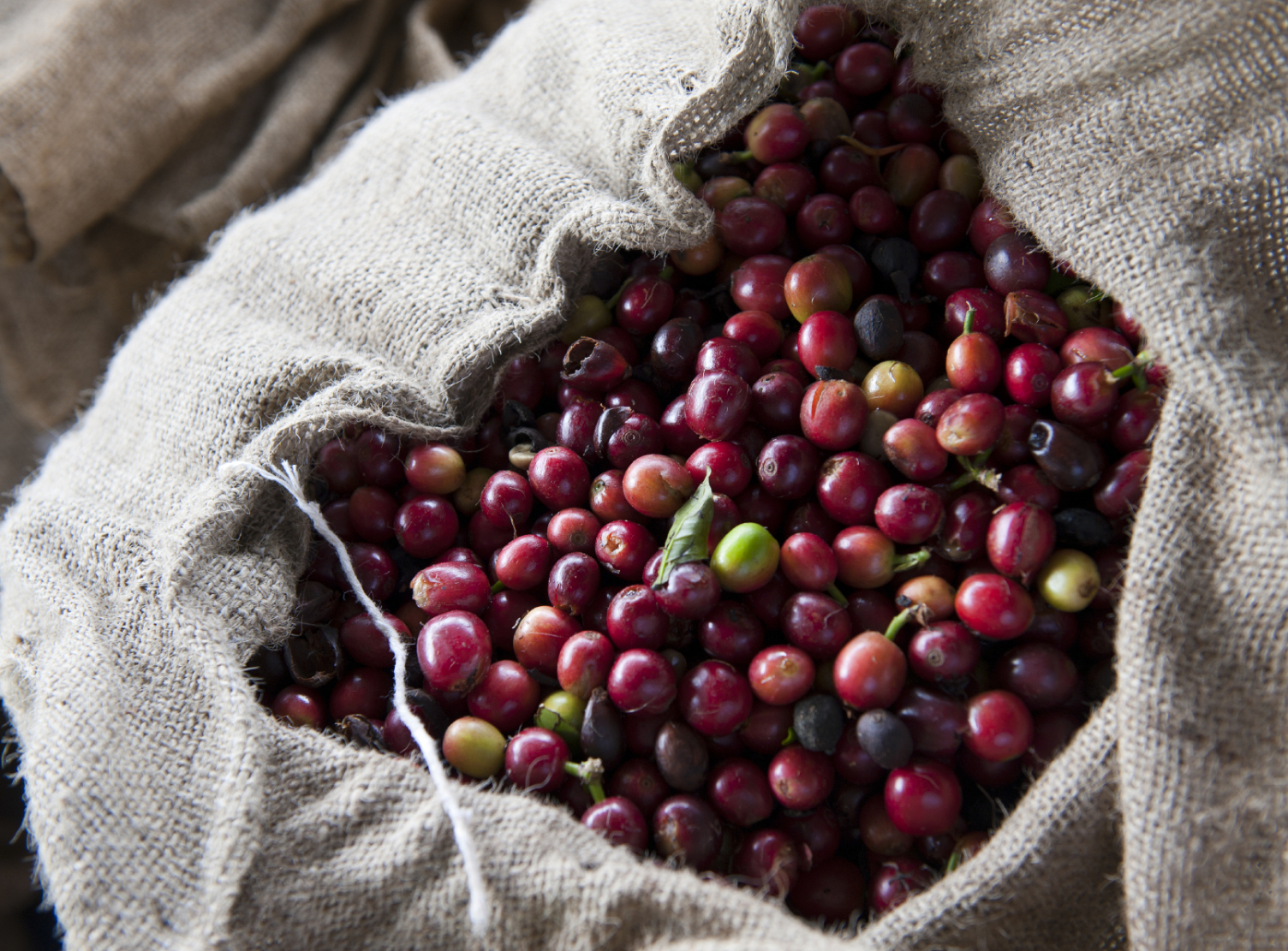
With more than 2.25 billion cups enjoyed worldwide every day, coffee is the planet’s single most valuable traded food commodity. [1]
Coffee’s effectiveness as high-performance brain fuel makes it liquid gold, and it’s not surprising that coffee’s primary active ingredient, caffeine, is the globe’s most commonly used psychoactive drug. The connection between caffeine’s main botanical source – the coffee plant – and our own biochemistry is one of nature’s best hacks.
“The fact is that 85% of the U.S. population consumes caffeine every single day,” says Sally Greenberg, the National Consumer League’s executive director. “And while we know where to find it, and [we] consume a lot of it, the majority of Americans are not ‘caffeine literate.’” [2]
Knowing how something works and where it comes from before you put it in your body is totally Bulletproof. With that in mind, this article delves deeper into the sourcing, quality, and benefits of coffee and caffeine. We’ll talk about:
- Coffee plant botany
- The perils of moldy coffee
- Caffeine and genetics
- How caffeine works in your brain
- How to get more from your coffee
Let’s get started.
Where do coffee beans come from?
There are two types of coffee plant: Coffea arabica is the source of Arabica coffee, and it accounts for 80% of the coffee that companies produce worldwide. The remaining 20% is Coffea canephora, commonly called Robusta coffee. [3] The leaves of both plants contain caffeine. In chemical terms, caffeine is a bitter, white crystalline solid called an alkaloid. Coffee plants produce it using nitrogen they take from soil. [4]
Ironically, the world’s favorite stimulant is actually the coffee plant’s defense mechanism. Caffeine’s bitter taste is meant to deter hungry herbivores, pests, and disease. [5] [6] [7] It’s also a “no trespassing” sign to other territory-stealing plants. [8]
Some animals can get over the bitter taste, though, and those that do tend to love both coffee and caffeine. Humans are a great example. Interestingly, so are bees. The bees get a stimulant effect from caffeine that’s similar to the one you experience. The bees love it, and it works well for the coffee plant, too: bees pollinate coffee plants like crazy. [9]
Recent research shows that the coffee plant uses a different set of genes to produce caffeine from those found in tea, cacao, and other such plants. Science suggests that coffee and tea shared a common ancestor 100 million years ago. Since then, each has evolved to produce caffeine in a very different way. [10] It’s clear that the coffee plant was caffeine’s favorite – coffee has twice as much caffeine as tea does. [11]
The coffee you drink contains the caffeine found in the coffee plant’s seeds, otherwise known as the beans. Caffeine from the beans is particularly powerful and flavorful, giving coffee its unique taste. A cup of coffee contains around 80-175mg of caffeine, depending on the bean and process by which it’s prepared. [12]
From bean to mean: moldy coffee makes you weak
Studies on health and coffee almost never account for the way companies grow and process the beans. Coffee beans thrive in hot, damp climates, so most growers are in South America and Africa. Processing plants are often nearby.
Where there’s hot, damp weather, there’s the possibility for mold. A recent study found that 91.7% of green coffee beans were contaminated with mold. [16] Green coffee is unprocessed, and coffee often grows even more mold during processing. Many facilities don’t clean their processing tanks between batches of coffee beans. Mold grows at the bottom of the tanks, where it contaminates the coffee.
Several species of coffee mold create mycotoxins, toxic byproducts that have serious implications for your health. [13] Studies link mycotoxins to brain damage, weight gain, cancer, hypertension, kidney disease, and numerous other health problems. [14] [15]
You’ll want to think twice about cheap, low-quality coffee. Many coffee companies sell their contaminated coffee in America. Coffee rejected by places with high mold standards, like Europe and Japan, are redirected to the U.S. for sale because the FDA’s standards for mold and toxin contamination are some of the lowest in the world. Bulletproof works with our growers to ensure a low toxin, no mold process. More about that later.
Caffeine and genetics
Do you have that one friend who can drink five cups of coffee a day and still sleep like a baby, while you keep buzzing for 8 hours after a single serving of joe? Thank your parents; the reason may lie in your genetics. [17]
Caffeine sensitivity varies from person to person. [18] Here’s why: the enzyme CYP1A2 metabolizes coffee in your liver. And how much CYP1A2 you create depends on your (appropriately named) CYP1A2 gene. [20] Slight changes in this gene can affect how a person processes caffeine. [21] Furthermore, another gene called AHR regulates the CYP1A2 gene, switching it on and off, and changes in your AHR gene can affect how much it regulates CYP1A2. [19] [20]
There’s even more genetics at play in your morning coffee. The Harvard School of Public Health found 6 new genetic variants associated with the way people metabolize caffeine. Their 120,000-person study revealed:
- 2 genes related to how coffee metabolism. Those who drink more coffee are likely to have unusual forms of these genes.
- 2 genes associated with how caffeine affects the brain with positive reinforcement. Big coffee drinkers are more likely to have variants of the genes that lead to increased levels of serotonin in the brain in response to caffeine (making those people feel especially rewarded and happy from caffeine).
- 2 genes that regulate fat and sugar in the blood stream as a response to caffeine. These genes had not been previously linked before to caffeine’s neurological effects. People who drink more coffee often have a mutation that influences glucose sensing in the brain. [21]
No two coffee drinkers are alike. Your genetic combinations and brain chemistry build your unique relationship with caffeine.
Your brain on caffeine
When caffeine hits the brain it suppresses a neurotransmitter called adenosine. Adenosine influences attention, alertness, and sleep. It builds up in your brain as the day goes on, like mercury rising in a thermometer. When adenosine hits a certain level, your body decides it’s bedtime. You have trouble staying awake and paying attention. When you sleep, adenosine resets, the thermometer drops back to zero during the night, and you wake up in the morning alert and ready to go.
Caffeine competes with adenosine. It binds to certain receptors in the brain like a key fitting into a lock. If caffeine is in the lock, adenosine can’t bind, and it can’t make you sleepy. By blocking adenosine, caffeine keeps the cell running, and keeps you awake. [22]
When caffeine blocks adenosine, stimulating brain chemicals like glutamate and dopamine join the party and flow more freely — giving you a surge of energy, improving mental performance, and slowing age-related mental decline. [23] Caffeine also increases serotonin, a major mood influencer. The boost makes you feel more positive, and it’s strong enough to measurably affect depression. [24] That’s right: a morning cup of coffee can make you a happier person.
Studies also show that caffeine improves learning by up to 10%. [25] Caffeine can even relieve headaches and migraines by constricting blood vessels in the brain that are opening too wide. [26] That makes drinking coffee one of the easiest brain performance hacks ever.
Upgrade your coffee
The coffee plant deserves a slow clap. It has fueled economies, cultures, technologies, science, and so much more. For a Bulletproof mind and body, set yourself up to get the best of what coffee has to offer.
Follow these tips when you drink Bulletproof Coffee and other caffeinated beverages:
- Buy single estate coffee beans. You’ll know exactly where they are coming from.
- Don’t buy “blends” of coffee. They are usually a mix of cheap beans from multiple sources.
- Avoid decaf coffee (unless it’s with the Upgraded decaf process). Caffeine is the coffee plant’s (and bean’s) natural pesticide and antifungal agent. When a bean is decaffeinated, it is defenseless and open to mold growth in later stages of processing.
- Arabica beans are generally less moldy than Robusta beans (for both cheap and expensive coffees).
- Avoid natural processed beans. Although the phrase sounds nice, it means the beans are left outside and often collect debris and bird feces. Natural process is very common in Africa.
- Be wary of the wet process, which isn’t much better than the natural process. Beans are fermented in water to remove skins and become susceptible to toxins.
- Consider the environment in which your beans grow. Mold is less common at higher elevations, so the mountains of Central or South America are solid choices. Bulletproof beans are harvested from a single family-owned estate in Guatemala, 1250 feet above sea level.
- Whether they’re monks, hippies, or locals, buy hand-picked coffee from experienced coffee harvesters who know how to pick only perfectly ripe beans for their peak effectiveness.
- Steam can help break down mycotoxins, making americanos a better choice than black coffee if you get caught without Upgraded beans.
- Decalcify your coffee making equipment with vinegar (a natural anti-fungal) every few months depending on how hard your water is.
- Always brew your coffee with filtered water.
- The Bulletproof Coffee recipe calls for grass-fed butter instead of cream because butter has all the healthy benefits of fat without the damaging effects of casein (there’s a little bit of casein in butter, but not enough to affect most people. If you’re very sensitive to casein, use ghee! It’s butter that’s been clarified and is casein-free!) . It also calls for Brain Octane oil, 18x stronger than regular coconut oil for maximum cognitive function.
- Find the best roasters in your city who work with quality beans. If you’re in Los Angeles, the new Bulletproof Cafe is opening up in Santa Monica!
How do you take your coffee? Share your results and experiences around your daily coffee routine in the comments. If you’re getting bored with your standard approach, check out this list of 15 things you can add to your coffee. Experiment a little, switch things up, and stay Bulletproof!
Check out how we make our new Dark Roast coffee
[expand title=”Click to read the complete list of references.” swaptitle=”Click to hide references.”]
[1] http://www.slu.edu/x95828.xml
[2] http://www.nclnet.org/caffeine_awareness_month
[3] http://www.coffeeresearch.org/agriculture/coffeeplant.htm
[4]http://www.ebi.ac.uk/chebi/searchId.do;A9D0B3A3FA3FAB91D48BBB7876D6AD59?chebiId=CHEBI:27732
[5]http://www.smithsonianmag.com/science/five-coffee-mysteries-beans-genes-may-crack-180952614/?no-ist
[6] http://www.sciencemag.org/content/345/6201/1181
[7] http://www.annualreviews.org/doi/abs/10.1146/annurev-arplant-042110-103854
[8] http://www.ncbi.nlm.nih.gov/pubmed/20139738
[9] http://www.sciencemag.org/content/345/6201/1181
[10] http://www.sciencemag.org/content/345/6201/1181
[12] http://en.wikipedia.org/wiki/Caffeine
[13] http://pubs.acs.org/doi/abs/10.1021/jf00011a028
[14] http://www.ncbi.nlm.nih.gov/pubmed/9263649
[15] http://www.ncbi.nlm.nih.gov/pubmed/21954354
[16] http://www.ncbi.nlm.nih.gov/pubmed/14726276
[17] http://www.geneplanet.com/genetic-analysis/list-of-analyses/caffeine-metabolism.html
[18] http://www.geneplanet.com/genetic-analysis/list-of-analyses/caffeine-metabolism.html
[19] http://www.ncbi.nlm.nih.gov/pubmed/21357676\
[20] http://www.geneplanet.com/genetic-analysis/list-of-analyses/caffeine-metabolism.html
[21] http://www.gbhealthwatch.com/Trait-Caffeine-Consumption.php
[22] http://www.caffeineinformer.com/caffeine-sensitivity
[23] http://www.caffeineinformer.com/caffeine-sensitivity
[24] http://www.medicalnewstoday.com/articles/285194.php
[25] http://www.jneurosci.org/content/22/15/6321.short
[26]http://www.nature.com/neuro/journal/v17/n2/full/nn.3623.html
[27] http://www.medicalnewstoday.com/articles/285194.php
[28] http://www.ncbi.nlm.nih.gov/pmc/articles/PMC3296361/
[/expand]









